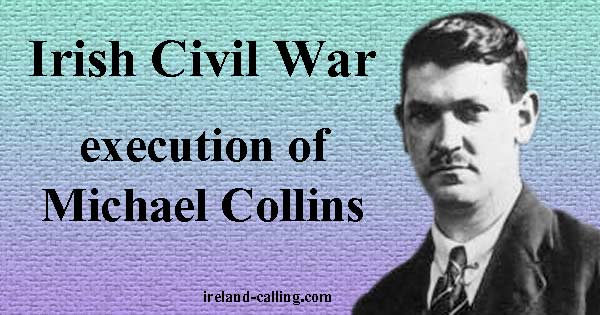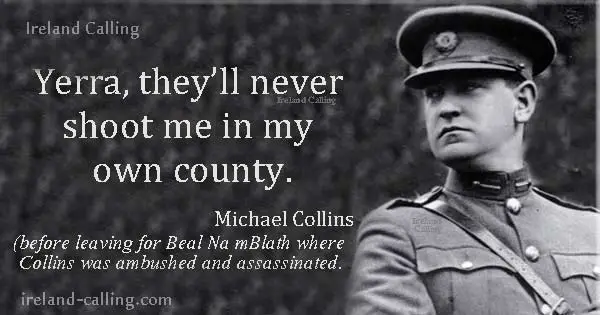The anti-treaty IRA had less weaponry and resources than their Free State enemy during the Irish Civil War.civil-war-top.htmlLiam Lynch, one of the anti-treaty leaders, knew that his troops were underdogs against the Free State. He set up a stronghold of anti-treaty volunteers in Munster, and placed his resources on protecting that position. He ordered the anti-treaty to adopt the same guerrilla tactics that had been used by the IRA in the War of Independence.

The anti-treaty volunteers attacked Free State soldiers in ambush attacks and short, sharp bursts. This enabled them to maximise their limited resources. They were able to achieve several small victories using this method, as the Free State troops would often not have time to call for reinforcements.
Execution of Michael Collins
In August 1922, Michael Collins made a trip to his home county of Cork. He had been advised that it was a dangerous journey, as Cork was one of the few cities that the anti-treaty IRA had control over. However, he was determined to make the trip, and reportedly said: “They won’t shoot me in my own county.” Collins had already survived more than one attempt on his life, and was privately aware that he was an IRA target and could be killed at any time.

The convoy was spotted by an anti-treaty spy, who recognised Collins in one of the vehicles. He told his superiors and an ambush was set up on the road in case the convoy returned later. It did, and bullets were fired by the anti-treaty at Collins and his men. Instead of fleeing, Collins and his men got out of their cars and returned fire. Collins was fatally wounded in the gunfight.
Free State under pressure
10 days earlier Arthur Griffiths had collapsed and died of suspected heart failure. The Free State were suddenly without their two figureheads and there was a fear that the party could crumble under the pressure of the anti-treaty attacks. Richard Mulcahy took over the party leadership and steadied the ship.
The anti-treaty couldn’t take advantage of the Free State’s uncertainty. They lacked the resources to do anything more than carry out sporadic attacks and focused much of their attention on trying to disrupt the Free State Army by destroying key railways and roads.
Executions and atrocities
The Free State put the country in a state of martial law, which meant anyone found in possession of a firearm, found guilty of doing damage to public buildings or attacks on Free State officials could be subject to a military trial and potentially sentenced to death by firing squad.
The Free State began executing IRA prisoners. Kevin O’Higgins, a member of the Free State government, ordered 77 executions, including Rory O’Connor, who had been the best man at his wedding. The anti-treaty murdered O’Higgins’ father and burnt down the family home in response.
Anti-treaty forced to “dump their weapons”
The anti-treaty troops were losing faith and morale after the executions of their captured comrades. A meeting was held and it was decided to continue with the war. However, Liam Lynch was killed shortly after, and other senior figures Dan Breen and Todd Andrews were arrested, Frank Aiken ordered a ceasefire fr0m the IRA troops on 30th April 1923. Éamon de Valera urged the volunteers to “dump their weapons” rather than hand them over to the Free State.
Thousands of anti-treaty IRA members were arrested and imprisoned. Éamon de Valera tried to rally the troops by telling them the future of the nation lay in their hands. About two thirds went on hunger strike but to no avail. Most were released within a few months. Many still wanted to fight for an independent republic, but that had now become a political matter rather than military one.
civil-war.html”]
